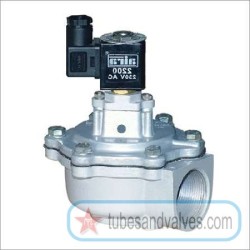Dust Collector Solenoid Pulse Valve
The dust collector solenoid pulse valve is an essential component of many dust collection systems, providing an accurate, automated means of cleaning dust particles. Pulse valves allow the dust collector to flush away dust and debris, ensuring the air quality is kept at an optimum level. This type of valve also helps protect the agitator when in use and prevents clogging. There is a range of solenoid pulse valves available, each with its own features and benefits.
Design Basics
A dust collector solenoid pulse valve features a cylindrical body housing with two tubes. One socket connects to a source of compressed air and the other to a vacuum source. Inside the valve body, there is a port, at one end of which is a solenoid armature. When the solenoid is energized, it is pulled magnetically to the armature, allowing the air to pass through the port and creating a pulse of air.
The other end of the port has a diaphragm, which is a membrane that holds back the pressure, controlling the flow. With the pulse of air passing through, the diaphragm allows the air pressure to be released out of the valve. This is how a dust collector solenoid pulse valve works.
Functionality
The solenoid pulse valve allows a dust collector to effectively clean itself and filter air continuously with minimal effort. The pulse of air created by the solenoid works in tandem with the diaphragm to create a intermittently released flow. This intermittent flow allows the valve to force the dust particles down the tube of dust collectors. With the dust being flushed away, the agitator is not blocked and there is no clogging.
Additionally, the diaphragm in the valves is also able to adjust the air flow. Depending on the application, the pressure of the air flow can be easily adjusted up or down. This means the dust collector can be optimally configured to fit the needs of each situation. The solenoid pulse valve also allows for quick release, so the cleaning cycle of the dust collector can be quickly activated, without waiting for the dust particles to settle.
Additional Benefits
One of the main advantages of using a solenoid pulse valve is it can help reduce the maintenance needs of a dust collector since regular cleaning cycles are no longer required. In addition, due to the automated nature of the valve, it eliminates unnecessary human intervention, thus reducing the potential for human error. The valve is also easy to install and use, making it ideal for any dust collection system.
The dust collector solenoid pulse valve is an efficient and reliable component of any dust collection system. By providing automated cleaning cycles and allowing for precise control of air flow, the solenoid pulse valve helps ensure air quality is kept at an optimum level. Whether the need is for industrial or domestic use, a solenoid pulse valve is an ideal solution.
Dust Collector Soleniod Pulse Valve FAQ's
Dust Collector Soleniod Pulse Valve FAQ's
What is a Dust Collector Soleniod Pulse Valve?
A Dust Collector Soleniod Pulse Valve is an electromechanical device that controls the flow of compressed air in a dust collector system. It is used to clean the filters of the dust collector system by sending a pulse of compressed air through them, which dislodges the dust












































